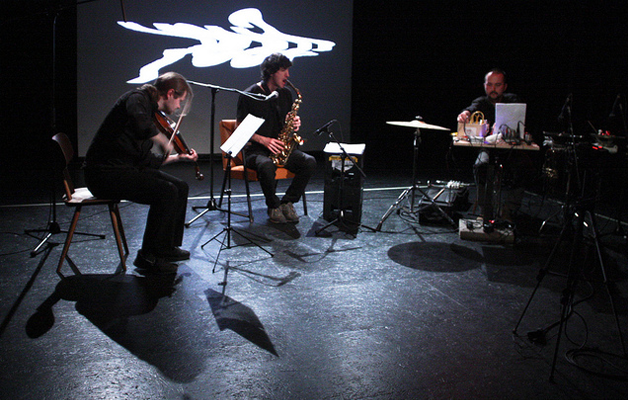Dátum/Idő
11.24. 20:00
Kategória(k)
////////////////for english description please scroll down///////////////
Dunkeltherapie …after the End in Seven Chapters
Andrej Gál: cselló
Milan Paľa: hegedű
Michal Matejka: elektromos gitár
Miroslav Tóth: ének, szopránszaxofon, kompozíciók
A Dunkeltherapie egy experimentális zenei projekt, ami szokatlan hangszerösszetételével, hangszínkombinációival és extrém lassúságával tekint a felszín alá. A tisztán struktúrált dalok zeneszerzője, Miroslav Tóth, énekesként és szaxofonon is közreműködik. Zenésztársai, Andrej Gál csellón, Milan Pal’a hegedűn klasszikus zenészek, Michal Matejka pedig az elektronika sötét anyagával itatja át az együttes hangzását.
…after the End in Seven Chapters
A “Vég Után Hét Fejezetben” adja a koncert keretét, ami voltaképpen egy hét tételes szvit. Megírt részek és improvizációk küzdenek meg egymással, black metál stílusú kommentárok simulnak össze vonós üveghangokkal, free jazz kirohanások ütköznek posztromantikus dallamokkal – a végeredmény egy feszültséggel és jelenidejű impulzusokkal életre keltett kortárs kamarazene.
https://vimeo.com/50075400
http://www.andrejgal.sk/
http://www.milanpala.com/
www.soundcloud.com/
Mindezt Bartha Márk vezeti be igazi 21. századi noise-beatbox-elektronika szettjével.
Bartha Márk – laptop, mikrofon
Belépő: 1000 HUF
Támogatói jegy: 1500/2000 HUF, mellyel a Jazzaj Extrák létrejöttét támogathatod.
ENGLISH
The new experimental project Dunkeltherapie comes in a completely different lineup with a new concept of music at an extremely slow pace, in extreme sound combinations, yet with a clear structure of the songs with no drums… “I wanted to slow down so we can see what’s underneath the bottom.” That is what Miroslav Tóth, the leader of the band, says of their new album. Tóth, the composer, vocalist, and saxophone player managed to put together a rare formation of players and improvisers performing seven compositions or lessons from a suite …after the End in seven chapters. Each musician is characterized by an obsessive passion for his/her instrument. They are musical hitchhikers, explorers with an experience in the genre destined for new discoveries-the improvised music. There is a paradox, though: they got models, even melodies to perform. They were incorporated into a predefined form, into shredded sheets of music, sections of modulations, and different methods of melodic work. They are neither performers nor improvisers. The project concludes in contemporary music. The string section – Milan Paľa (violin) and Andrej Gál (cello) – is a skeleton of the project. As for the instrumentation and also structurally, the pieces model the cello’s part. Pre-composed parts and respective work with the material make it an indicator of the process. Along with the violin, it cuts and sets asunder the pre-composed parts of the work. Gál’s work with the instrument is about contemplating about extreme exertion of the sound in all positions. It is all backed by his rich experience from concert work as a soloist or in ensembles for contemporary music, free improvisation projects or the interpretation of Baroque music. Often tuning down C string and creating always fresh parallelisms, you may ask whether he plays in unison with the bass (Chapter VI.). No, Gál does it all by himself. He is a true illusionist of the instrument playing with proper confidence, exploring the limits of the cello. The Slovak virtuozo violinist Paľa not only responses convincingly; in some moments, she creates tension against Gál. The string section is enough to give rise to remarkable moments of concertante interaction. The very melodic unisons are, ultimately, the moments of mutual accord – in tunings the string players are used to from collective performance of classical music. In our case, both of the string players possess an open sonic palette. Paľa sets off to the upper register and gives centrifugal solos.Making use of flageolets and positions sul ponticello, she plays in unison with the cello. Having experience of multi-genre performance in different ensembles, she oscillates between harsh and delicate sound qualities, between post-romantic expressiveness and free jazz or even intuitive improvisation.
The string section is a melodic sound timbre embracing in its centre bizarre vocals which make important part of the overall voicings. Extensive vocal techniques mixed with black metal commentaries of the process and sporadic extreme saxophone explosions (Tóth) make their claim for narration. The voice imparts transparency, narration to the compositions and soothes, yet deepens their ghastly expressiveness.The voice imparts transparency, narration to the compositions and soothes, yet deepens their ghastly expressiveness. The most important ‘black’ work, so to speak, is done by Michal Matejka, amalgamates the ensemble. He is a kind of player who cannot miss in the ensemble creating its very sound.
Andrej Gál: cello (http://www.andrejgal.sk/)
Milan Paľa: violine (http://www.milanpala.com/)
Michal Matejka: el. gitara ( www.soundcloud.com/
Miroslav Tóth: vocal, sopr. saxophone, compositions
video, trio: https://vimeo.com/
https://vimeo.com/50075400
Ticket: 1000 HUF
Supporter Ticket: 1500/2000 HUF


